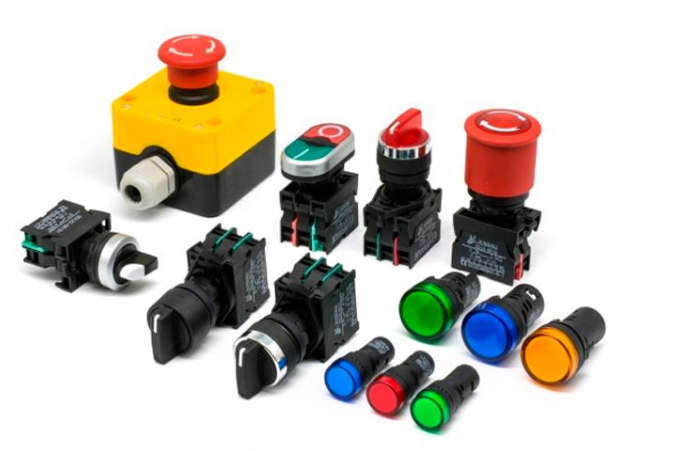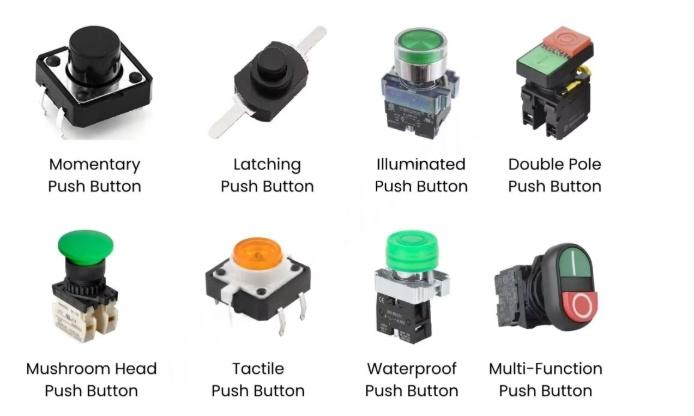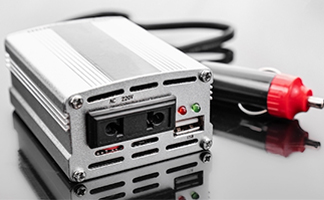Push Button Switches 101: How They Work, How to Choose, and Uses
Author:admin Date: 2025-11-05 07:17 Views:40
Introduction
If you want a simple but tactile interface to control electrical circuits, consider the push button switches.
So, a push button switch is a type of switch used for controlling an electrical circuit through pressing a button. This action breaks or makes an electrical connection, interrupting or allowing the flow of current.
Push buttons can either be mechanical or electronic. Mechanical switches rely on physical mechanisms such as springs and contacts. Each time you press the button, the spring is compressed, bringing the two metal contacts together to complete the circuit. The mechanical switches are known for their reliability and robustness.
Electronic push button switches are smarter with more sensors and other electronic components that can detect the press without relying on physical moving parts. Such switches offer more precision, flexibility, and programmable features.
This guide takes a deeper look at the various types of push button switches, how they work, how to troubleshoot them, and more.

How Push Button Switches Work
A push button for light switches or any other type has a simple mechanism that controls the electrical circuit. The internal mechanism has components such as:
- The actuator is the external part of the switch that the user presses or manipulates to make or break the circuit.
- The spring mechanism is vital for providing the force to return the actuator and contacts to their original positions once the pressure is removed.
- Electrical contacts are the conductive metal parts in the switch housing. They can be made of copper with gold or silver plating for better conductivity.
So, what happens when the button is pressed?
Whenever a user applies pressure to the push button switch’s actuator, it moves downward to compress the internal spring. This physical movement forces the contacts to touch, closing the circuit, or to move away, opening the circuit. Pushing the actuator allows the current to flow or stops it entirely.
If you release the button, the spring pushes the switch actuator back to the default position, and the contacts also revert to their original state.
Key Specifications and Parameters of Push Button Switches
Consulting the manufacturer’s datasheet is important to understand the specifications of the push button switches. Below are the main specifications to keep in mind.
Electrical Ratings
These are essential parameters that indicate the switch’s safety rating for handling the electrical load of a circuit.
Voltage: This is the maximum voltage, whether DC or AC, that the switch is designed to handle without breaking the insulating material or causing electrical arcing across the contacts.
Current: This is the maximum current in amperes that the contacts can reliably switch. The rating is vital to prevent the contacts from overheating or degrading prematurely.
Contact resistance: This is the electrical resistance across closed contacts. Having a low initial contact resistance is important for efficiency, which also minimizes energy loss and heat generation.
Insulation resistance: This is the resistance of the insulating material between the terminals and the switch housing. This value should be higher, indicating good electrical safety, which also prevents current leakage.
Mechanical Rating
These are the specifications that relate to the physical operation and durability of the push button switches. Examples include:
Button travel: It is the distance the actuator must move to change the state of the contacts. This is how the tactile is affected and the time needed to actuate the switch.
Actuation force: It is the amount of force needed to press the button. Such is vital for ergonomics, preventing accidental activation, and user experience.
Mechanical life cycles: It is the number of times the switch can be actuated without having a mechanical failure. High-quality switches will have hundreds of thousands of cycles before they break.
Material Considerations
These are the materials used in making the switches. They can determine if the switch is good for certain environments over others.
Plastic vs. Metal: You will find the plastic switches are mostly made of ABS or Nylon thus cost-effective and lightweight. They still offer good electrical insulation and are suitable for general household or indoor applications.
As for metal push button switches, they offer superior durability and impact resistance. They are more robust to feel, making them ideal for outdoor or industrial applications.
Heat and UV Resistance: The material used to make such switches should be able to withstand the high temperature ranges and still resist potential degradation from UV light in case they are used outdoors.
Size Variations
You may come across different-sized options in the market. It depends on the mounting hole diameters. You have options such as 8mm, 12mm, 16mm, 19mm, 22mm, and more.
So, choose the switch depending on the available panel space, user interaction needs, and required visibility.
You can use the small-sized switches for compact electronic or portable devices. The large-sized switches can work well for industrial control panels, emergency stop functions, and public spaces where high visibility and ease of operation are necessary.
Environmental Ratings
This will save you a lot in terms of finding the right push button switch. This is also referred to as the Ingress Protection (IP) and Impact (IK) ratings. So, pick the right switch depending on which elements it will be exposed to.
The IP waterproof classifications indicate the protection against solids and liquids. You have options such as IP65, IP67, and IP68.
As for impact ratings (IK), they indicate the degree of protection against mechanical impacts. This is important for addressing vandalism in public areas.
Applications of Push Button Switches
Push button switches can be found in many devices. Below is a detailed list of where you can find such button types.
- Consumer electronics such as power buttons, reset switches, and gaming devices
- Home and commercial appliances such as kitchen appliances, HVAC control panels, and automation systems
- Industrial and manufacturing sectors, where we have switches for machine control, such as start and stop controls
- Automotive and transport sector with options such as dashboard buttons, horn switches, and others.
- Hobby electronics or DIY projects, such as Arduinos, where you can wire such switches to achieve a certain function. The same applies to robotics.
Types of Push Button Switches

There are a couple of options under the types of push button switches. They are largely categorized based on how they work, design materials, the intended environment of use, and other special features.
- Momentary Push-Button Switches
For these types of switches, they remain in their actuated state so long as the pressure remains applied. Whenever the user releases the button, the internal spring returns the contacts to their unpressed or normal state.
Examples include doorbells, keyboards, and reset buttons.
- Latching Push Button Switches
These switches can maintain their state even with pressure released. Let us assume the switch is in the OFF state. When pressed, the internal mechanism locks it in the ON state. You have to press it again to toggle it back to OFF.
These switches are good for functions that need a continuous state change, unlike momentary buttons. Examples include power buttons to switch on TVs, computers, or lighting applications.
- Illuminated Push-Button Switches
These types of switches have a light source, such as an LED, within or around the actuator. The light provides feedback based on the switch’s status. For example, you can have a green or red light showing that the switch is on. Some colors can indicate an error with the system.
- Anti-Vandal Push-Button Switches
The anti-vandal switches are designed and built for extreme durability and resistance to abuse. You are likely to find them in public settings, where they might be subjected to abuse. They are mostly made of robust stainless steel or similar alloys.
They are highly waterproof and boast high IK-rated impact resistance.
We recommend them for pedestrian crossings, elevators, outdoor machinery, and much more.
- Industrial Push-Button Switches
These are made with heavy-duty components to work flawlessly in industrial settings. We all know they can be pretty harsh, so it helps to know they can work well.
They also feature robust construction and high IP ratings for resistance to water, dust, and oil. They largely have modular designs that allow the contact blocks to be stacked.
These switches are also vibration-resistant for use in machinery applications.
- Emergency Stop Push Buttons Switches
The E-stops are critical safety devices that you have to install depending on the operations. They halt a machine process in any emergency situation by overriding all the other controls.
These switches comply with strict international safety standards to ensure they always work and are easily identifiable. For example, they have large, prominently red mushroom heads on a yellow background.
- Miniature and Micro Push-Button Switches
These switches are designed to fit in small spaces but still deliver on the high-quality performance of push-button switches. Tactile switches are the most common and offer a satisfying click when pressed.
Expect to find these switches in consumer electronics, IoT devices, hearing aids, and more.
- Smart and Touch-Sensitive Push-Button Switches
This is what you can expect from modern interfaces. They do not have the traditional mechanical moving parts. They simply use capacitive switches. In this case, they detect the finger’s touch through electrical capacitance. It is the same thing you get with a smartphone screen.
These switches are pretty reliable, as mechanical components are minimized. Also, they can work with a wide range of devices.
Wiring and Installation of Push Button Switches
Wiring and installing the push button switches can be easy. It all depends on understanding how the switch works so that you can wire it correctly.
Understand the Terminals
It is key to identify the correct terminals. Check out the datasheets of the switches to find clear diagrams of each switch type.
Expect to come across NO/NC terminals, LED terminals, and much more. Usually, the manufacturer explains what each terminal does.
Wiring Configurations
Wiring largely depends on whether it is a momentary or latching switch. Also, the complexity of the desired circuit is important.
The single pole wiring is the most simple setup you can come across. You will find two terminals which are NO or NC that are wired to control a single circuit.
There can be other sophisticated setups such as dual-LED wiring. Make sure to consult the manual to understand how best you can wire the switch to achieve a certain operation.
Mounting Methods
Once you are done with the wiring, next would be mounting. Proper mounting is essential to ensure the switch is accessible, secure, and also functions as expected.
The mounting options include panel mounting, PCB mounting, and snap-fit buttons.
Panel mounting is a common industrial and anti-vandal switch you can buy today. They are easy to mount by drilling into a control panel. As for PCB mounting, they are miniature and tactile switches designed to be mounted on Printed Circuit Boards (PCB).
The snap-fit buttons are designed to simply snap into a pre-cut opening and hold in place securely. They are common in the automotive sector.
Soldering and Connection Tips
Make sure that you make safe and reliable connections. They are crucial for long-term performance. The choice of wire is important as it should based on the current rating of the switch and application. If the wires are too thin, they can lead to overheating and fire hazards.
Soldering might be necessary sometimes. Make sure to use a soldering iron with temperature control. You should avoid overheating the terminals, as it can melt some of the switch components.
Common Problems With Push Button Switches
The push button switches are usually robust, however, they can develop issues with time due to wear and tear, improper installation, or environmental factors. Here are some notable issues:
- Sticky or Jammed Buttons
This is where the button does not return to its original position, or it is difficult to press. Dirt and debris are the most common causes. If they keep lodging around the actuator shaft, they will eventually interfere with its operation.
Wear and tear is another common issue. This happens over many cycles of using the switch. The components may deform, making it harder to gain free movement.
Poor design and installation, such as the wrong mounting hole, causes the housing to pinch the actuator shaft. This leads to sticking. Also, low-quality switches may have poor manufacturing tolerances, which leads to jamming even when the switches are new.
- Contact Failure
Contact failure means that the switch cannot reliably make or break the circuit when actuated.
Corrosion, carbon buildup, and overcurrent are common causes of contact failure.
Moisture, harsh chemicals, and humidity can cause corrosion. The metal contacts will rust of oxidize, making it hard for current to flow. In such cases, it is best to replace the switch.
- LED Illumination Issues
Illuminated switches may also experience issues such as burned-out LEDs, incorrect wiring, or voltage mismatches.
The burned-out LEDs are possible if you have been using the push-button switch for a long time. Also, this can occur due to reverse polarity during installation or incorrect wiring.
- Intermittent Switching
This type of switch randomly disconnects and reconnects without user interaction. This mostly happens because of loose wires, vibrations, and poor solder joints.
Loose wires in vibrating machines or vehicles make the contacts to keep engaging and disengaging. This can lead to an unreliable connection.
Conclusion
Push-button switches are simple devices that make it easier to control different devices. For example, they can serve as an interface between human operators and the machines they handle. Expect to encounter these switches across different fields, from doorbell switches to capacitive touch switches in IoT devices. Just make sure you are getting from top brands to ensure performance.
Please send RFQ , we will respond immediately.
Frequently Asked Questions
What does the term Normally Open (NO) mean in push button switches?
NO means that the electrical contacts inside the switch are open when the button is in its resting, unpressed state. Once you press the button, you close the circuit. It is different from Normally Closed (NC), where the contacts are touching and pressing the button opens the circuit.
Can you use push-button switches with any voltage?
No. Switches come with a maximum voltage and current rating they can handle. This information is on their spreadsheet. Exceeding these ratings can lead to failure of the switch.
What does the IP rating, such as IP67, mean?
The IP rating indicates how well the switch is sealed against liquids and dust. For example, the IP67 rating means the switch is totally protected against dust and withstands temporary immersion in water up to 1 meter deep.


